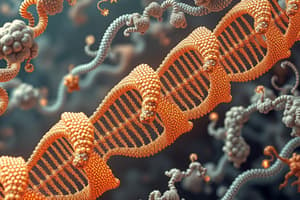Podcast
Questions and Answers
Protein fractionation is essential for isolating a specific protein from a complex mixture. What is the MOST direct outcome of this process?
Protein fractionation is essential for isolating a specific protein from a complex mixture. What is the MOST direct outcome of this process?
- Obtaining a purified sample of the protein of interest for further analysis. (correct)
- Increasing the overall entropy and disorder of the protein mixture.
- Randomly denaturing most of the proteins to reduce sample complexity.
- Determining the precise atomic structure of all proteins in the sample.
In protein fractionation, several properties can be exploited to achieve separation. If you wanted to separate proteins based solely on their size, which method would be MOST appropriate?
In protein fractionation, several properties can be exploited to achieve separation. If you wanted to separate proteins based solely on their size, which method would be MOST appropriate?
- Affinity chromatography.
- Ion exchange chromatography.
- Isoelectric focusing.
- Gel filtration chromatography. (correct)
When using salt precipitation for protein fractionation, increasing the salt concentration can lead to the precipitation of proteins. At what specific salt concentration does a given protein precipitate?
When using salt precipitation for protein fractionation, increasing the salt concentration can lead to the precipitation of proteins. At what specific salt concentration does a given protein precipitate?
- It is consistent across all proteins due to uniform structure.
- It is universally high, because all proteins precipitate at same high salt concentrations.
- It is unpredictable, because any salt concentration above zero can cause precipitation.
- It depends uniquely on the protein's solubility characteristics. (correct)
In the context of protein precipitation using ammonium sulfate, what underlying principle explains why proteins become less soluble at high salt concentrations?
In the context of protein precipitation using ammonium sulfate, what underlying principle explains why proteins become less soluble at high salt concentrations?
Dialysis is a protein purification technique. How does it work to separate proteins?
Dialysis is a protein purification technique. How does it work to separate proteins?
Protein electrophoresis separates proteins based on their charge-to-mass ratio. Which factor MOST directly affects the movement of a protein through the gel matrix?
Protein electrophoresis separates proteins based on their charge-to-mass ratio. Which factor MOST directly affects the movement of a protein through the gel matrix?
In gel electrophoresis, what is the role of the gel matrix (e.g., polyacrylamide) in separating proteins?
In gel electrophoresis, what is the role of the gel matrix (e.g., polyacrylamide) in separating proteins?
You are analyzing a gel after performing protein electrophoresis and notice that smaller proteins have migrated farther from the well compared to larger proteins. What is the MOST accurate interpretation of this observation?
You are analyzing a gel after performing protein electrophoresis and notice that smaller proteins have migrated farther from the well compared to larger proteins. What is the MOST accurate interpretation of this observation?
During centrifugation, particles separate based on their physical properties. For a particle to sediment to the bottom of the tube, how must its density relate to the density of the surrounding solvent?
During centrifugation, particles separate based on their physical properties. For a particle to sediment to the bottom of the tube, how must its density relate to the density of the surrounding solvent?
Which type of centrifugation involves separating particles based on their sedimentation rate through a density gradient, leading to distinct bands?
Which type of centrifugation involves separating particles based on their sedimentation rate through a density gradient, leading to distinct bands?
How does chromatography achieve separation of molecules in a mixture?
How does chromatography achieve separation of molecules in a mixture?
What determines the classification of chromatography as either liquid chromatography (LLC, LSC) or gas chromatography (GSC, GLC)?
What determines the classification of chromatography as either liquid chromatography (LLC, LSC) or gas chromatography (GSC, GLC)?
In thin-layer chromatography (TLC), what serves as the stationary phase?
In thin-layer chromatography (TLC), what serves as the stationary phase?
Which type of chromatography separates molecules based on their specific biological affinity for a particular ligand?
Which type of chromatography separates molecules based on their specific biological affinity for a particular ligand?
Consider a scenario where a protein mixture is subjected to ion exchange chromatography. If the column is designed to bind negatively charged proteins, what type of resin is MOST likely used?
Consider a scenario where a protein mixture is subjected to ion exchange chromatography. If the column is designed to bind negatively charged proteins, what type of resin is MOST likely used?
In gel filtration chromatography, molecular weight determination of macromolecules relies MOST directly on what property of the stationary phase?
In gel filtration chromatography, molecular weight determination of macromolecules relies MOST directly on what property of the stationary phase?
Plasma protein fractionation is often used to isolate therapeutic proteins. If you want to obtain immunoglobulins from plasma, which initial step is MOST commonly used?
Plasma protein fractionation is often used to isolate therapeutic proteins. If you want to obtain immunoglobulins from plasma, which initial step is MOST commonly used?
Which statement ACCURATELY describes the role of centrifugation in plasma protein fractionation?
Which statement ACCURATELY describes the role of centrifugation in plasma protein fractionation?
Cold ethanol fractionation is a method used in plasma protein purification. What principle underlies the use of cold ethanol in this process?
Cold ethanol fractionation is a method used in plasma protein purification. What principle underlies the use of cold ethanol in this process?
You are tasked with purifying a specific enzyme from a complex cellular extract. To begin, you need to disrupt the cells while maintaining the enzyme’s activity. Which method is MOST appropriate for this initial step?
You are tasked with purifying a specific enzyme from a complex cellular extract. To begin, you need to disrupt the cells while maintaining the enzyme’s activity. Which method is MOST appropriate for this initial step?
After preparing a tissue extract, you need to determine the BEST approach for protein fractionation. Which factor should be considered to select the MOST appropriate technique to isolate the protein?
After preparing a tissue extract, you need to determine the BEST approach for protein fractionation. Which factor should be considered to select the MOST appropriate technique to isolate the protein?
A researcher is using electrophoresis to separate proteins but observes broad, diffuse bands instead of sharp, well-defined bands. What adjustment is MOST likely to improve the resolution of the protein separation?
A researcher is using electrophoresis to separate proteins but observes broad, diffuse bands instead of sharp, well-defined bands. What adjustment is MOST likely to improve the resolution of the protein separation?
A protein sample is being prepared for gel filtration chromatography. What would be the MOST important consideration to ensure optimal separation?
A protein sample is being prepared for gel filtration chromatography. What would be the MOST important consideration to ensure optimal separation?
In affinity chromatography, after the target protein binds to the immobilized ligand, what is the MOST common method used to elute the bound protein?
In affinity chromatography, after the target protein binds to the immobilized ligand, what is the MOST common method used to elute the bound protein?
A researcher aims to purify a protein with a known isoelectric point (pI) of 7.0 using isoelectric focusing. To ensure optimal focusing, what pH gradient range should the researcher establish?
A researcher aims to purify a protein with a known isoelectric point (pI) of 7.0 using isoelectric focusing. To ensure optimal focusing, what pH gradient range should the researcher establish?
When performing salting out, a protein precipitates at a certain salt concentration. What is the effect of further increasing the salt concentration beyond this point?
When performing salting out, a protein precipitates at a certain salt concentration. What is the effect of further increasing the salt concentration beyond this point?
A researcher is using dialysis to remove ammonium sulfate from a protein solution. Which specific property of the dialysis membrane is MOST crucial for the effective removal of the salt?
A researcher is using dialysis to remove ammonium sulfate from a protein solution. Which specific property of the dialysis membrane is MOST crucial for the effective removal of the salt?
If a protein does not bind to the affinity column, what would happen?
If a protein does not bind to the affinity column, what would happen?
In size exclusion chromatography, which molecules elute FIRST from the column?
In size exclusion chromatography, which molecules elute FIRST from the column?
Reverse phase chromatography is MOST useful for proteins with which of the following properties?
Reverse phase chromatography is MOST useful for proteins with which of the following properties?
Which type of chromatography is MOST effective for purifying a fusion protein tagged with a specific peptide sequence?
Which type of chromatography is MOST effective for purifying a fusion protein tagged with a specific peptide sequence?
Why is it important to use mild conditions during cell lysis when preparing a protein extract for fractionation?
Why is it important to use mild conditions during cell lysis when preparing a protein extract for fractionation?
Which of the following is a PRIMARY consideration when choosing a protein fractionation technique?
Which of the following is a PRIMARY consideration when choosing a protein fractionation technique?
If you want to separate proteins based on structural characteristics, which technique would be appropriat?
If you want to separate proteins based on structural characteristics, which technique would be appropriat?
What determines the separation of proteins during electrophoresis?
What determines the separation of proteins during electrophoresis?
In a mixture of 3 proteins, if you perform differential centrifugation, what determines which protein precipitates first?
In a mixture of 3 proteins, if you perform differential centrifugation, what determines which protein precipitates first?
In immunoaffinity chromatography, which of the following is required?
In immunoaffinity chromatography, which of the following is required?
Flashcards
Protein Fractionation
Protein Fractionation
A process to isolate a single or multiple types of protein from a complex mixture.
Purpose of Protein Fractionation
Purpose of Protein Fractionation
Commercial products like enzymes, nutritional proteins, biopharmaceuticals, research, quantification, protein structure studies, and post-translational modifications.
Steps in Protein Purification
Steps in Protein Purification
Develop assay, choose protein source, prepare extract, fractionate, determine purity.
Properties in Protein Fractionation
Properties in Protein Fractionation
Signup and view all the flashcards
Ion exchange
Ion exchange
Signup and view all the flashcards
Electrophoresis
Electrophoresis
Signup and view all the flashcards
Isoelectric focusing
Isoelectric focusing
Signup and view all the flashcards
Adsorption chromatography
Adsorption chromatography
Signup and view all the flashcards
Paper chromatography
Paper chromatography
Signup and view all the flashcards
Reverse phase chromatography
Reverse phase chromatography
Signup and view all the flashcards
Hydrophobic interaction
Hydrophobic interaction
Signup and view all the flashcards
Dialysis
Dialysis
Signup and view all the flashcards
Gel electrophoresis
Gel electrophoresis
Signup and view all the flashcards
Gel filtration
Gel filtration
Signup and view all the flashcards
Ultracentrifugation
Ultracentrifugation
Signup and view all the flashcards
Affinity chromatography
Affinity chromatography
Signup and view all the flashcards
Immunopurification
Immunopurification
Signup and view all the flashcards
Salt precipitation
Salt precipitation
Signup and view all the flashcards
Detergent solubilization
Detergent solubilization
Signup and view all the flashcards
Protein Fractionation Techniques
Protein Fractionation Techniques
Signup and view all the flashcards
Salting Out
Salting Out
Signup and view all the flashcards
Salting In
Salting In
Signup and view all the flashcards
Salting Out Mechanism
Salting Out Mechanism
Signup and view all the flashcards
Salting In Mechanism
Salting In Mechanism
Signup and view all the flashcards
Ammonium Sulfate Use
Ammonium Sulfate Use
Signup and view all the flashcards
Why use NH4SO4?
Why use NH4SO4?
Signup and view all the flashcards
Dialysis definition
Dialysis definition
Signup and view all the flashcards
Dialysis membrane process
Dialysis membrane process
Signup and view all the flashcards
Purpose of Dialysis
Purpose of Dialysis
Signup and view all the flashcards
Protein Electrophoresis
Protein Electrophoresis
Signup and view all the flashcards
Electrophoresis separation
Electrophoresis separation
Signup and view all the flashcards
Purpose of electrophoresis diagnostic test
Purpose of electrophoresis diagnostic test
Signup and view all the flashcards
Movement rate in Gel Electrophoresis
Movement rate in Gel Electrophoresis
Signup and view all the flashcards
Centrifugation
Centrifugation
Signup and view all the flashcards
Centrifugation principle
Centrifugation principle
Signup and view all the flashcards
Chromatography
Chromatography
Signup and view all the flashcards
Chromatography separation
Chromatography separation
Signup and view all the flashcards
Chromatography Type
Chromatography Type
Signup and view all the flashcards
Thin Layer Chromatography
Thin Layer Chromatography
Signup and view all the flashcards
Paper Chromatography
Paper Chromatography
Signup and view all the flashcards
Column Chromatography
Column Chromatography
Signup and view all the flashcards
Study Notes
Protein Fractionation
- Protein fractionation is key to protein identification
- A process used to isolate single or multiple types of proteins from complex mixtures
- Protein fractionation isolates, identifies, and characterizes proteins
Protein Purification Steps
- Develop assay
- Choose protein source
- Prepare tissue extract through cell disruption or subcellular fractionation
- Protein fractionation goes through several steps
- Determination of purity
Protein Fractionation Techniques
- Appropriate techniques depend on size and shape
- Solubility, stability, and sedimentation velocity factor in as well
Strategy of Fractionation
- Fractionation procedures isolate based on physical characteristics
- Charge is one characteristic and can be achieved through:
- Ion exchange
- Electrophoresis
- Isoelectric focusing
- Polarity is another characteristic and can be achieved through:
- Adsorption chromatography
- Paper chromatography
- Reverse phase chromatography
- Hydrophobic interaction
- Size is another characteristic and can be achieved through
- Dialysis
- Gel electrophoresis
- Gel filtration
- Ultracentrifugation
- Specificity occurs through:
- Affinity chromatography
- Immunopurification
- Solubility occurs through
- Salt precipitation
- Detergent solubilization
Techniques
- Dialysis, Precipitation, Centrifugation, and Filtration
- Ultrafiltration, Electrophoresis, and Chromatography
Salting Out
- Most proteins are less soluble at high salt concentrations
- The salt concentration where a protein precipitates depends on the protein
- Salting out will fractionate a protein
Salting In vs Salting Out
- Salting in: Low salt increases the solubility of charged molecules and prevents aggregation/precipitation
- Salting out: High salt competes with water to solvate macromolecules
- High salt removes the solvation sphere from proteins to precipitate them
Ammonium Sulfate Precipitation
- A method for large and laboratory-scale protein purification and fractionation
- Separates proteins by changing their solubility in high salt concentrations
- In an aqueous solution, ammonium and sulfate ions are attracted to opposite charges and purified
- Opposite charges prevent water molecules from interacting
NH4SO4 Benefits
- High solubility in water
- It generally has no harmful effects on most proteins
- Stabilizes proteins and stores proteins as ammonium sulphate ppt
- No real temperature effects
Dialysis
- Dialysis separates molecules by size using semi-permeable membranes
- Membranes have pores smaller than macromolecular dimensions
- Pores allow solvents, salts, and small metabolites to diffuse out but block larger molecules
- Removes waste products and excess fluid from the blood when the kidneys don't work properly
- Cellophane is a typical dialysis material
- Changes the solvent in which the protein dissolves
2 Dialysis
- Removes ammonium sulfate
- Solutes pass through a semipermeable membrane
- Pores in membrane are a certain size
- It removes ammonium and sulphate ions
- Proteins cannot pass through
Protein Electrophoresis
- Charged particles or molecules migrate under the influence of electric current
- Measures specific proteins in the blood
- Separates proteins in the blood based on their charge-to-mass ratio
Principle of Electrophoresis
- Movement rate depends on field strength, and amount of charge
- It is used in scientific labs because proteins travel through a gel matrix inside
- An electric current pushes the proteins through the gel
- Smaller proteins migrate faster, thus appear at the bottom of the gel
- Larger proteins take longer, and show up at the top
Electrophoresis - Medical
- This test finds abnormal M proteins
- The presence of M proteins is a sign of myeloma or multiple myeloma
- Can also test other proteins and antibodies like immunoglobulins
Centrifugation
- Fractionates particles from a solution based on size, shape, density, viscosity, and rotor speed
- Principle: In suspension, particles with different masses, and densities settle at different rates
- In a solution, particles whose density is higher than the solvent sink, and particles that are lighter than the solvent float
Types Based on Process
- Micro, high-speed, and ultracentrifuges can be used
- Differential and equilibrium density-gradient centrifugation
Chromatography
- Used to separate and identify mixture components
- Molecules distribute themselves between stationary and mobile mediums
- Chromatography works based on a molecule's time spent in the mobile phase; faster movement is determined by time spent in mobile phase
Chromatography Classification
- According to mobile phase: liquid such as (LLC, LSC) or gaseous such as (GSC, GLC)
- According to packing of the stationary phase:
- Thin layer chromatography (TLC) uses stationary phase supported by glass, plastic, or aluminum plates
- Paper chromatography (PC) uses a thin film of liquid supported on an inert material
- Column chromatography (CC) uses a column packed with a glass material
- According to the force of separation: adsorption, partition, ion exchange, gel filtration, and affinity chromatography
Plasma Protein Fractionation
- Involves changing the conditions of pooled plasma, such as temp or acidity
- Normal dissolved proteins in plasma because insoluble and precipitate out
- Insoluble protein can undergo centrifugation
- Effectiveness is achieved via the addition of alcohol to the pool while cooling the pool
- this is sometimes called cold alcohol or ethanol fractionation
- Humen serum albumin is prepared via this as a vaccine treatment
Studying That Suits You
Use AI to generate personalized quizzes and flashcards to suit your learning preferences.




